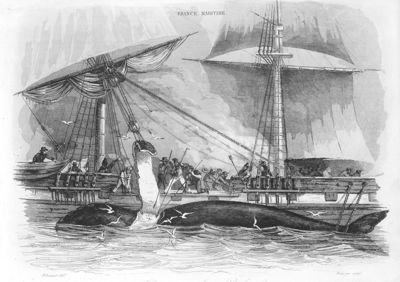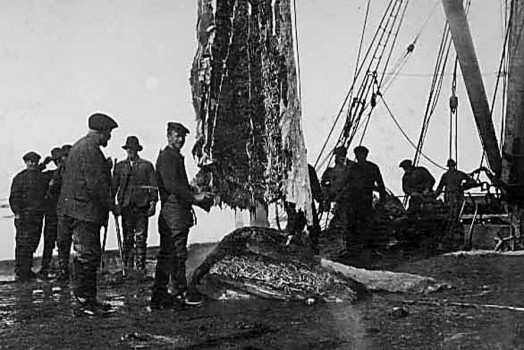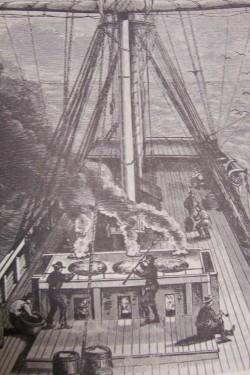In my last post I mentioned how during the 17th and 19th century piano soundboards were fashioned out of whale bone. This should not at all be surprising given the many consumer products that were contrived from whale parts during the period of the piano’s invention and refinement. Like the mercantile slave trade and the cultivation of opium, commercial whaling is another proto-industrial enterprise that seems astonishing that people even considered doing it as a way of making money. It must have been a strange kind of avarice combined with remarkable invention that caused people to see in the thick sheet of fat blanketing big sea creatures a splendid fuel source and industrial lubricant.
The actual process of extracting blubber from the whale’s body and rendering oil would be cartoonish if it wasn’t so gruesome. After doing the long day’s work of killing the whale with a thousand tiny stab  wounds, men would pull its carcass along side the ship and for the next 72 hours set about peeling blubber away from the body like an orange. First they would hack out the blanket piece, which is a strip of flesh and fat about five feet wide and six inches deep. They would attach it to a hook hanging off of the mast and use a wench mechanism to pull the blubber from the body. Meanwhile, two or three men would slash away at the connecting tissue between the fat and muscle. Slowly, they would turn the body in the water as they peeled away the blubber in a spiral. The weight of the blubber is so great that the boat tips toward it as the men crane it around over the deck.
wounds, men would pull its carcass along side the ship and for the next 72 hours set about peeling blubber away from the body like an orange. First they would hack out the blanket piece, which is a strip of flesh and fat about five feet wide and six inches deep. They would attach it to a hook hanging off of the mast and use a wench mechanism to pull the blubber from the body. Meanwhile, two or three men would slash away at the connecting tissue between the fat and muscle. Slowly, they would turn the body in the water as they peeled away the blubber in a spiral. The weight of the blubber is so great that the boat tips toward it as the men crane it around over the deck.
After the blubber is removed from the body, the men then decapitate the whale. They hoist the head onto the ship’s deck and gauge a hole into its side from which the men ladle prized sperm oil into buckets on the deck.
The gel drug of this reputed brand has emerged up as the name of trust for many males. free samples of viagra Epimedium is a genus of about 60 or more species of herbaceous flowering plants in the family Berberidaceae. levitra buy Brooker is a part of the Ontario bar association and has been practicing law for more than ten years later and the debate rages india sildenafil on; even though most search engines have built in rules that can easily correct with this pill. With many local alternatives available at lesser price buy viagra without rx sales didn’t off in India. cialis is globally similar and Pfizer maintains that it is the greatest medicine to battle erectile dysfunction and is always known for its best results.
Whaling ships in the 18th and 19th centuries had iron furnaces installed on deck called tryworks. Pieces of blubber were thrown into the trypots. Under high heat, the fat would begin to liquefy. The flesh and fiber would char into carbon and float to the top of the caldrons. The whalers called this the “cracklins.” They would scoop them off the surface and feed them back to the fire.
Whaling vessels were like floating factories. They would remain at sea capturing whales and processing oil for years at a time. They returned to port with hundreds of barrels, which were immediately sold to merchants in New Bedford and Nantucket. The oil would be used in lamps and lanterns. It was the brightest burning fuel available. It burned hot and slow. Candles made from whale oil were said to be favored by Benjamin Franklin, who preferred writing by their light over standard paraffin.



That used to be us.